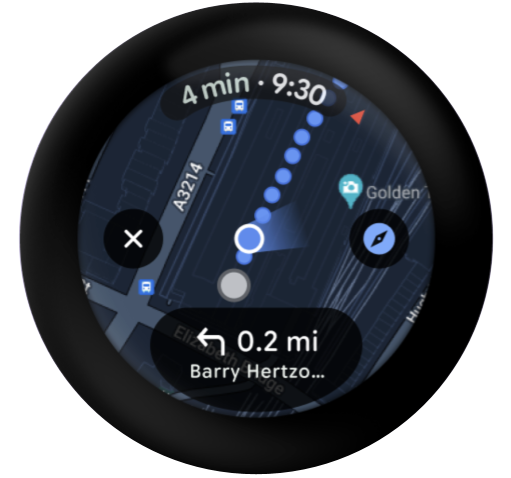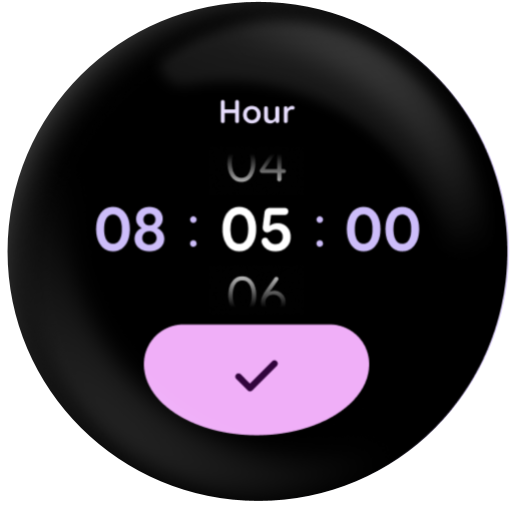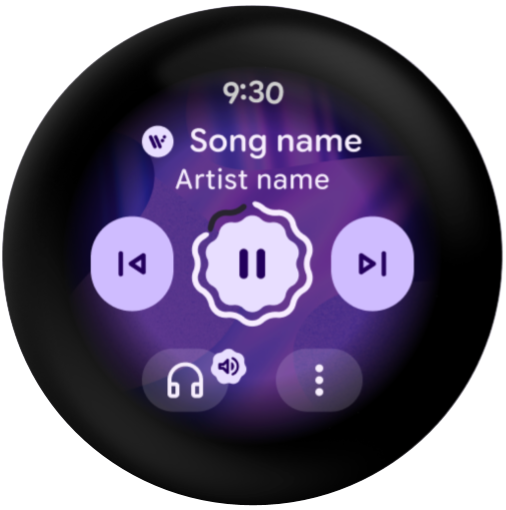แอปคือมุมมองที่เน้นการจัดการงานที่ซับซ้อนเกินกว่าจะใช้ ภาวะแทรกซ้อน ไทล์ หรือการแจ้งเตือน แอปใน Wear OS จะคล้ายกับส่วนติดต่อผู้ใช้หลักของแอปบนอุปกรณ์เคลื่อนที่ ใช้พื้นผิว เช่น ไทล์ คอมพลิเคชัน และ การแจ้งเตือน เพื่อทำงานให้เสร็จ แต่ให้ลิงก์พื้นผิวเหล่านี้ไปยังแอป เพื่อทำงานที่ซับซ้อนกว่า
โปรดอ่านหลักการและกรณีการใช้งานต่อไปนี้เพื่อให้เข้าใจแอปได้ดียิ่งขึ้น
หลักการ UX
ออกแบบแอปโดยคำนึงถึงหลักการต่อไปนี้
โฟกัส
มุ่งเน้นแอปไปที่งานสำคัญเพื่อช่วยให้ผู้ใช้ทำสิ่งต่างๆ ให้เสร็จได้ภายในไม่กี่วินาที เพื่อหลีกเลี่ยงความไม่สบายตามหลักสรีรศาสตร์หรืออาการเมื่อยล้าที่แขน
ตื้นและเชิงเส้น
หลีกเลี่ยงลำดับชั้นที่ลึกกว่า 2 ระดับ แสดงการนำทางในบรรทัด
เลื่อน
มุมมองสามารถเลื่อนได้ ซึ่งเป็นท่าทางที่ผู้ใช้คุ้นเคยในการดูเนื้อหาเพิ่มเติมบนนาฬิกา
กรณีที่ควรใช้แอป
ใช้แอปในสถานการณ์ต่อไปนี้
ดูข้อมูลเพิ่มเติม
มุ่งเน้นแอปไปที่งานสำคัญเพื่อช่วยให้ผู้ใช้ทำงานให้เสร็จได้ภายในไม่กี่วินาที เพื่อหลีกเลี่ยงความไม่สบายตัวหรืออาการเมื่อยล้าที่แขน

เพื่อการโต้ตอบที่สมบูรณ์ยิ่งขึ้น
เพื่อให้การโต้ตอบที่สมบูรณ์ยิ่งกว่าการแทรกข้อมูลหรือไทล์

สำหรับกิจกรรมที่ใช้เวลานาน
เพื่อรองรับกิจกรรมที่ใช้เวลานาน เช่น การออกกำลังกายและการเล่นสื่อ

สร้างแอป
Jetpack Compose เป็นชุดเครื่องมือ UI สมัยใหม่ที่อธิบายอย่างชัดเจนและเป็น แนวทางที่แนะนำสำหรับการสร้างแอปใน Wear OS
ในกรณีส่วนใหญ่ UI ที่ใช้ Jetpack Compose จะมีโค้ดน้อยลงและ เร่งกระบวนการพัฒนาแอป Android โดยรวม ดูข้อมูลเพิ่มเติมเกี่ยวกับข้อดีทั่วไปของเฟรมเวิร์ก UI แบบประกาศได้ที่หัวข้อเหตุผลที่ควรใช้ Compose
Compose สำหรับ Wear OS เป็นไปตามการออกแบบที่สื่ออารมณ์ของ Material 3 มีฟีเจอร์การช่วยเหลือพิเศษในตัว และใช้การกำหนดธีม Material ซึ่งช่วยให้คุณ ปรับแต่งการออกแบบให้เหมาะกับแบรนด์ได้ Compose สำหรับ Wear OS ออกแบบมาเพื่อช่วยคุณ สร้างประสบการณ์ของผู้ใช้ที่เป็นไปตามหลักเกณฑ์การออกแบบของ Wear OS
คำแนะนำในการสร้างแอปด้วย Compose สำหรับ Wear OS
หากต้องการสร้างประสบการณ์การใช้งานที่ดีที่สุดเท่าที่จะเป็นไปได้โดยใช้ Compose สำหรับ Wear OS โปรดอ่านคำแนะนำต่อไปนี้
- ใช้ Jetpack Compose ใน Wear OS: ดูวิธีสร้างด้วย Compose สำหรับ Wear OS
- สร้างรายการ: ดูวิธีสร้างรายการที่ได้รับการเพิ่มประสิทธิภาพสำหรับ อุปกรณ์ที่สวมใส่ได้
- การไปยังส่วนต่างๆ ด้วย Compose สำหรับ Wear OS: ดูข้อมูลเพิ่มเติมเกี่ยวกับการสร้าง การนำทางใน Compose
- จัดการอินพุตแบบหมุนใน Wear OS: ดูข้อมูลเพิ่มเติมเกี่ยวกับวิธีจัดการ อินพุตแบบหมุนใน Wear OS
- รองรับขนาดหน้าจอของอุปกรณ์ต่างๆ : ดูข้อมูลเพิ่มเติมเกี่ยวกับวิธี ตรวจสอบว่าแอปควรทำงานได้ดีในอุปกรณ์ Wear OS ทุกขนาด
- ประสิทธิภาพของ Compose ใน Wear OS: ดูข้อมูลเพิ่มเติมเกี่ยวกับประสิทธิภาพและ การทดสอบประสิทธิภาพของแอป

